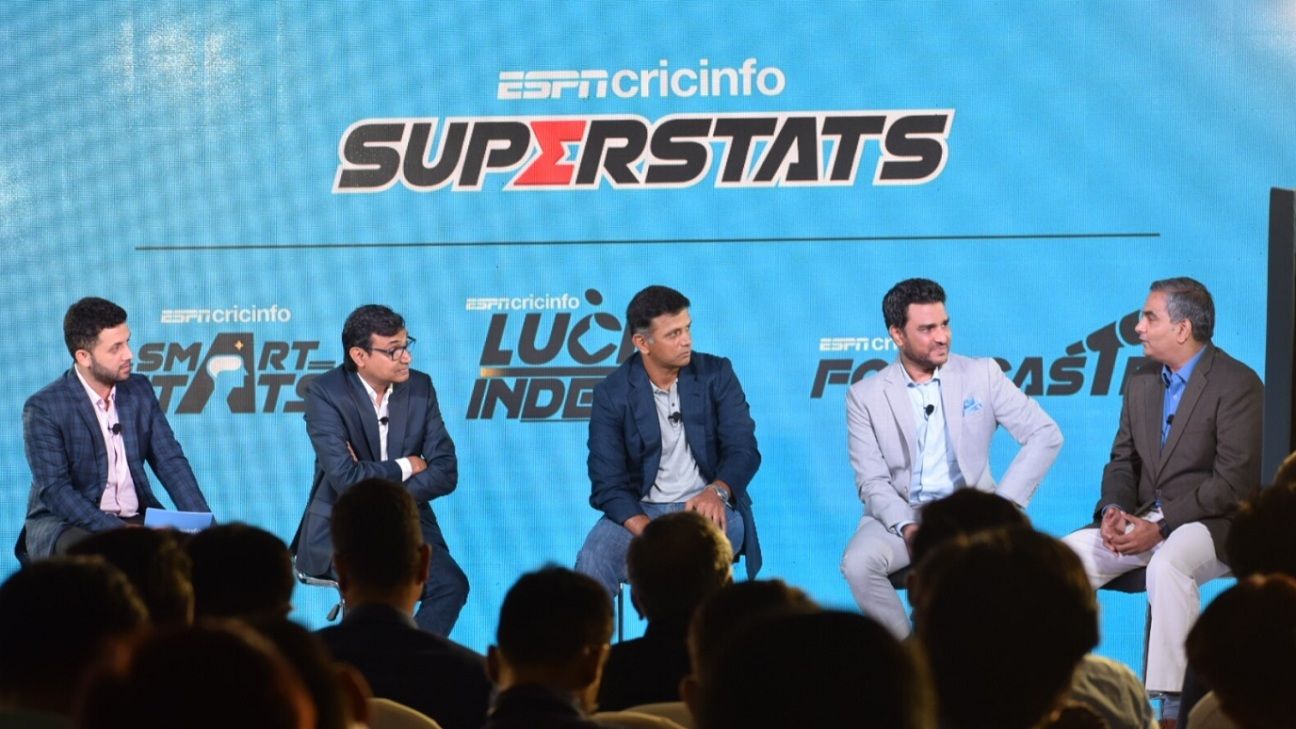A slice of luck – a dropped catch to be exact – could well have saved, and extended, Rahul Dravid‘s career, the man himself reckoned at the launch of ESPNcricinfo’s Superstats, a set of new-age metrics for a more nuanced understanding of the modern game.
Dravid spoke about how a top-edge off Stuart Broad fell in no-man’s land in the Mohali Test of England’s tour of India in 2008, and allowed him to score a career-saving hundred, leading to a “couple of good years (in international cricket)” thereafter.
Dravid was on 1 when the chance was missed, and went on to make 136. ESPNcricinfo’s ball-by-ball commentary wondered if “that’s a bit of luck for Dravid”, something Luck Index – one of three elements that make up Superstats, Smart Stats and Forecaster being the others – attempts to quantify for T20 cricket.
Dravid was part of a panel that also featured Sanjay Manjrekar and ESPNcricinfo’s editor-in-chief Sambit Bal, along with Dr Raghunathan Rengaswamy of IIT Madras, whose team collaborated with ESPNcricinfo’s team of statisticians to develop Superstats. The new stats language, available for T20 cricket to start with, has been derived by putting our rich ball-by-ball data through complex algorithms developed by Gyan Data, an IIT-M incubated company founded by Raghunathan.
In the words of ESPN India head Ramesh Kumar, these Superstats “offer a final point of view to settle water-cooler debates and discussions on cricket” and “will validate cricketing wisdom”.
Bal said that while traditional numbers would continue to be around, Superstats added a “layer of quality and value to them”, and explained how it would mean “batsmen and bowlers are equalised” and measurable on a common metric that gauges their impact in a match.
Manjrekar, a well-travelled broadcaster, spoke about how such enhanced statistics would benefit commentators and fans watching live telecasts, especially in T20 tournaments like the IPL, which is followed by scores of data-savvy fans who are “fascinated by numbers”, than those who have grown up watching the longer formats.
Should these metrics have been available during his playing career, Manjrekar argued that “an Ajay Jadeja might have won Man of the Match in the 1996 World Cup quarterfinal” against Pakistan in Bengaluru, for the impact his innings had on the game’s result, and not Navjot Singh Sidhu, who ended up getting the award.
When asked if insights of the sort had helped him make informed decisions in his playing and coaching career, Dravid mentioned acquiring the services of Brad Hodge for Rajasthan Royals in the 2012 auction despite his middling returns in past editions of the tournament with other teams.
Royals, “pretty much a budget team at that stage”, went with Hodge to fill a middle-order spot despite the fact that on pitches such as in Jaipur – the Royals’ home ground – his “averages weren’t good, numbers weren’t great”. Dravid and Co picked Hodge as a death-overs finisher based on his compelling past record against pace bowling. His past failures were attributed to “playing in spin-friendly tracks in Kolkata and Kochi, falling often to left-arm spinners”.
Hodge, who put in a few match-winning performances in that role, had reportedly insisted that he bat at No. 3, only to be told by Dravid that “I don’t want your 450 runs at three, give me 200 runs at strike rate 160 facing the Mitchell Johnsons and Dale Steyns”.
Dravid spoke about how the conversation around T20 cricket based on conventional metrics “sometimes frustrated me as a player and a coach”, and how it was “fantastic to see people have finally recognised over the past few years” that the T20 game was a different beast.
Dravid and Manjrekar agreed that, with Superstats and other new-age metrics around, the critical thing was to “make the best use of these numbers” and arrive at meaningful conclusions.
The two former India batsmen did, however, debate at length about whether “geeks and nerds are taking over the game”, observing that while the likes of MS Dhoni and Virat Kohli would no doubt be better captains with such insights, there was “an emotional element to cricket, a human element to it”, which can never fully be explained by numbers.
Dravid argued that cricket would “never fully be taken over by the geeks, because while the numbers might tell you ‘bowl X on that day’, the captain knows better if he’s up for it, because numbers can’t quantify whether he’s carrying a niggle. As a coach, sometimes if captains take a gut call on the field, you tend to back them, as long as you know he’s not doing it blindly. I think a guy like Dhoni gets the feel of that (the game), better than most captains”.
